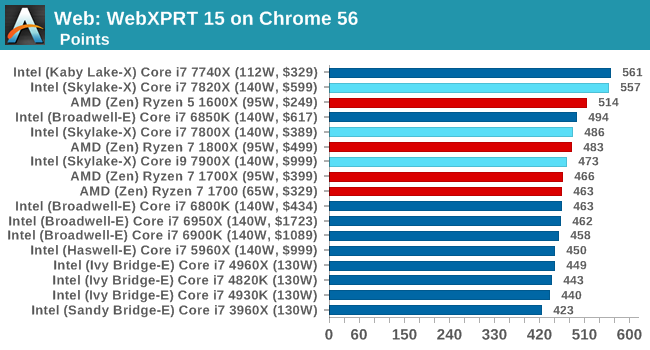The Intel Skylake-X Review: Core i9 7900X, i7 7820X and i7 7800X Tested
by Ian Cutress on June 19, 2017 9:01 AM ESTBenchmarking Performance: CPU Web Tests
One of the issues when running web-based tests is the nature of modern browsers to automatically install updates. This means any sustained period of benchmarking will invariably fall foul of the 'it's updated beyond the state of comparison' rule, especially when browsers will update if you give them half a second to think about it. Despite this, we were able to find a series of commands to create an un-updatable version of Chrome 56 for our 2017 test suite. While this means we might not be on the bleeding edge of the latest browser, it makes the scores between CPUs comparable.
SunSpider 1.0.2
The oldest web-based benchmark in this portion of our test is SunSpider. This is a very basic javascript algorithm tool, and ends up being more a measure of IPC and latency than anything else, with most high-performance CPUs scoring around about the same. The basic test is looped 10 times and the average taken. We run the basic test 4 times.

Sunspider goes after peak frequency most of the time, althoguh there is some variation as it moves into basically becoming a legacy test.
Mozilla Kraken 1.1
Kraken is another Javascript based benchmark, using the same test harness as SunSpider, but focusing on more stringent real-world use cases and libraries, such as audio processing and image filters. Again, the basic test is looped ten times, and we run the basic test four times.

Kraken is more of an intense attack on JS, and still regularly sorts by IPC and frequency.
Google Octane 2.0
Along with Mozilla, as Google is a major browser developer, having peak JS performance is typically a critical asset when comparing against the other OS developers. In the same way that SunSpider is a very early JS benchmark, and Kraken is a bit newer, Octane aims to be more relevant to real workloads, especially in power constrained devices such as smartphones and tablets.

Octane seems to be an optimization target, and with the new Skylake-X it shows.
WebXPRT 2015
While the previous three benchmarks do calculations in the background and represent a score, WebXPRT is designed to be a better interpretation of visual workloads that a professional user might have, such as browser based applications, graphing, image editing, sort/analysis, scientific analysis and financial tools.











264 Comments
View All Comments
Ian Cutress - Monday, June 19, 2017 - link
We didn't post gaming data in our launch Ryzen 7 review for the same reason. You are applying double standards.http://www.anandtech.com/show/11170/the-amd-zen-an...
melgross - Monday, June 19, 2017 - link
Man, another guy who didn't actually read the article, but reads other poster's remarks who also didn't read the article. Can't we just deleted these jerks remarks?koomba - Thursday, July 6, 2017 - link
Please go back and tag my reply on page 7. Short version: you are wrong, they did NOT do gaming benchmarks on their launch Ryzen review either.So quit whining about something that DIDN'T HAPPEN and using it as a weak excuse to bash this site. Your blatant AMD fan boy agenda is pathetic.
nicolaim - Monday, June 19, 2017 - link
Typos. Second table on first page says i7 instead of i9.nicolaim - Monday, June 19, 2017 - link
And incorrect MSRP for Ryzen 7 1800X.Ryan Smith - Monday, June 19, 2017 - link
Please be sure to reload. Both of those issues on the first page were corrected some time ago.Bulat Ziganshin - Monday, June 19, 2017 - link
I have predicted details of AVX-512 implementation 1.5 years ago when SKL-S microarchitecture was described in Intel optimization manual. These are details:http://www.agner.org/optimize/blog/read.php?i=415#...
Einy0 - Monday, June 19, 2017 - link
Very disappointed that AT did not publish game benchmarks because they didn't show Intel in the best light but had no problem making a big deal about Ryzen's gaming issues. This isn't the brand of journalism that Anand built this site on. It's certainly not what attracted me to the site and has had me coming back for 20 years. I come for unbiased straight shooting PC technology reviews. Now we get a mobile focus and biased PC hardware reviews. Not to mention the full screen popup ads and annoying hover ads that refuse to go away. How far the mighty have fallen!Ian Cutress - Monday, June 19, 2017 - link
We never posted Ryzen 7 gaming benchmarks in our launch review for the same reason. Please go back and check:http://www.anandtech.com/show/11170/the-amd-zen-an...
melgross - Monday, June 19, 2017 - link
You know, it almost doesn't pay to respond to these guys. They're AMD fanboys who are too lazy to read the article first, and they won't read your link either, because they don't want to. They want to believe what they say, no matter what.